From 16-feet nonvenomous snakes to 12-inch-long venomous snakes, Florida has an absolute abundance of snakes. In total, the Sunshine State has 53 species of snakes, six of which are venomous.
Check out the guide below to find out the ins and outs of all of the different snakes that inhabit Florida.
Table of Contents
Nonvenomous Snakes in Florida
1. African rock python

- Experience: Expert
- Family: Pythonidae
- Scientific Name: Python sebae
- Other Names: N/A
- Adult Size: 10-16 feet (3-5 meters)
- Lifespan: 20-30 years
- Average Price Range: $650-$1,000
The massive African rock python was established in Florida during the early 2000s. Currently, they are only known to be in Miami-Dade County. Outside of their size, these snakes can be recognized by the irregular dark blotches, bordered by black and white, that go down the back.
African rock pythons live in sawgrass prairies, melaleuca stands, agricultural areas, lakes, and even housing developments. Their diet revolves around mammals and birds.
2. Apalachicola kingsnake

- Experience: Intermediate to expert
- Family: Colubridae
- Scientific Name: Lampropeltis meansi
- Other Names: N/A
- Adult Size: 36-48 inches (92-122 centimeters)
- Lifespan: 15-25 years
- Average Price Range: $200-$250
As the name suggests, Apalachicola kingsnakes primarily live in the Apalachicola lowlands. They can be differentiated from other kingsnakes by their light coloration.
Usually, this species will have narrow crossbands with light colors in between or they’ll simply have yellow crossbands. Nevertheless, they’re lighter than other kingsnakes!
Apalachicola kingsnakes can be found in pinelands, hardwood hammocks, prairies, marshes, cypress streams, and along streams. They eat small mammals, small birds, lizards, turtles, and snakes—some of the snakes being even bigger than them!
3. Boa constrictor

- Experience: Expert
- Family: Boidae
- Scientific Name: Boa constrictor
- Other Names: Red-tailed boa, common boa
- Adult Size: 10-16 feet (3-5 meters)
- Lifespan: 25-30 years
- Average Price Range: $150-$200
These large snakes are usually tan or cream with dark brown hourglass-shaped crossbands going down the length of the body. Believed to be established in Florida in the 1970s, boa constrictors can only be found in Miami-Dade County.
Boa constrictors live in a variety of habitats (tropical hardwood hammocks, pine rocklands, swamps, and canals) and are known to feed mostly on rodents and opossums.
4. Black swamp snake

- Experience: N/A
- Family: Colubridae
- Scientific Name: Liodytes pygaea
- Other Names: Florida swampsnake
- Adult Size: 10-15 inches (25-38 centimeters)
- Lifespan: N/A
- Average Price Range: N/A
These small snakes are shiny and black with a bright red belly. The main difference between this species and the red-bellied mudsnake is that the black swampsnake does not have the pinkish red bars.
You could probably guess where they live via their name. That being said, black swampsnakes do live in swamps and other aquatic habitats on the mainland. They feed on earthworms, leeches, salamanders, and arthropods.
5. Brahminy blind snake

- Experience: N/A
- Family: Typhlopidae
- Scientific Name: Indotyphlops braminus
- Other Names: Flowerpot snake
- Adult Size: 4.4-6.5 inches (11.2-16.5 centimeters)
- Lifespan: N/A
- Average Price Range: $30
One of the most intriguing snakes on this list, the brahminy blindsnake is…yes, blind. Nonetheless, it does have eyes; they’re just very miniscule. These small, blind snakes made their way to Florida through the transportation of ornamental plants.
Often mistaken for earthworms, brahminy blind snakes can be found burrowed in soil from Key West throughout most of the peninsula. They’ve also been recorded in the Panhandle. They feed on the eggs of ants and termites.
6. Brown water snake
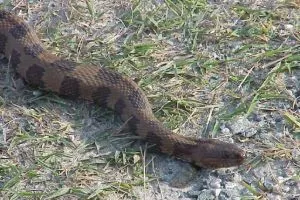
- Experience: Intermediate
- Family: Colubridae
- Scientific Name: Nerodia taxispilota
- Other Names: water-pilot, aspic, false moccasin, great water snake, pied water snake, southern water snake, water rattle
- Adult Size: 30-60 inches (76-152 centimeters)
- Lifespan: 6-7 years
- Average Price Range: $50
Brown watersnakes are stout-bodied, tan snakes with darker squarish blotches going down the body. Exempting the Florida Keys, they live everywhere in the state and can be found in rivers, swamps, lakes, ponds, canals, and other wetlands.
These snakes feed exclusively on fish, specifically catfish. They’re also great climbers.
7. Burmese python

- Experience: Expert
- Family: Pythonidae
- Scientific Name: Python bivittatus
- Other Names: N/A
- Adult Size: 10-16 feet (3-5 meters)
- Lifespan: ~20 years
- Average Price Range: $850-$2,000
The Burmese python is the largest snake in the state of Florida. In 2012, researchers captured a 17-foot-7-inch-long Burmese python in Everglades National Park, easily a record for the state.
Of course the length is a giveaway when recognizing these snakes, but you can also identify them based off their coloration. Their stout bodies are tan to cream with dark brown blotches going down the back and sides. The head is dark with a light stripe on both sides.
Burmese pythons were established in Florida in the 1980s. They mostly inhabit the undeveloped wetlands of the southern peninsula such as the Florida Everglades. Their diet consists of a handful of mammals, including deer. They’re also known to eat alligators on occasion.
8. Common garter snake
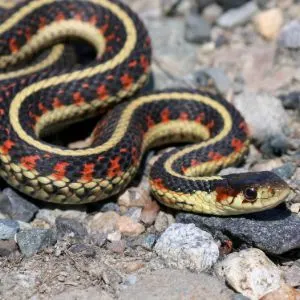
- Experience: Beginner
- Family: Colubridae
- Scientific Name: Thamnophis sirtalis
- Other Names: Blue-striped garter snake, eastern garter snake
- Adult Size: 18-26 inches (46-66 centimeters)
- Lifespan: 8-10 years
- Average Price Range: $30
Residing everywhere in the state except for the Florida Keys, common garter snakes occupy a wide range of habitats (pinelands, hardwood hammocks, cypress strands, prairies, marshes).
These slender snakes have a black, green, or gray background with three light-colored stripes going down the course of the body. The stripes are typically blue, green, brown, yellow, or white. They have a diet of fish, amphibians, and worms.
9. DeKay’s brown snake
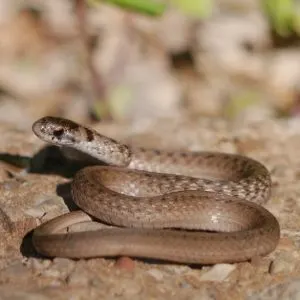
- Experience: Beginner
- Family: Colubridae
- Scientific Name: Storeria dekayi
- Other Names: Brown snake
- Adult Size: 9-13 inches (23-33 centimeters)
- Lifespan: ~7 years
- Average Price Range: $30
DeKay’s brownsnakes (named after American zoologist James Ellsworth De Kay) are typically brown or another darkish coloration. They also have light-colored stripes bordered by black dots. The top of their head is usually black with one or two dots around the neck area.
This secretive species lives underneath leaflitter, logs, and rocks in the Panhandle west of the Aucilla River. They feed on earthworms, snails, and slugs.
10. Eastern coachwhip

- Experience: Expert
- Family: Colubridae
- Scientific Name: Maticophis flagellum flagellum
- Other Names: N/A
- Adult Size: 42-60 inches (107-152 centimeters)
- Lifespan: 12-20 years
- Average Price Range: $100
Exempting the Florida Keys and most of the wetlands south of Lake Okeechobee, eastern coachwhips are found throughout the state. They prefer habitats with open canopies.
These slender, tan snakes often have a black head and neck. As the name implies, they do resemble a whip. The eastern coachwhip’s diet consists of birds, insects, lizards, small mammals, and other snakes.
11. Eastern hog-nosed snake
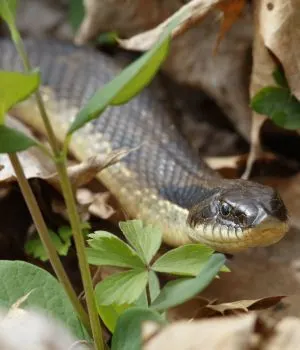
- Experience: Beginner to intermediate
- Family: Colubridae
- Scientific Name: Heterodon platirhinos
- Other Names: Puff adder, hissing sand snake, blow snake, cobra
- Adult Size: 20-33 inches (50.8-83.82 centimeters)
- Lifespan: ~12 years
- Average Price Range: $130
The first of two hognoses that live in the Sunshine State, the eastern hog-nosed snake lives in meadows and sandy areas throughout mainland Florida. This species has a pig-like nose, which is utilized for digging.
Coloration can range from yellow to gray with dark brown blotches. Eastern hognoses feed solely on amphibians. They will also hiss or play dead when they feel threatened, however, they’re ultimately harmless.
12. Eastern indigo snake
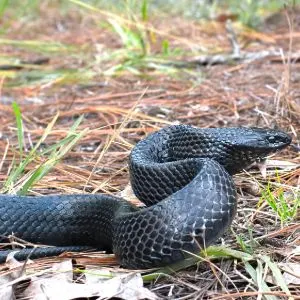
- Experience: Expert
- Family: Colubridae
- Scientific Name: Drymarchon couperi
- Other Names: Gulf coast indigo snake, blue gopher snake
- Adult Size: 60-82 inches (152-213 centimeters)
- Lifespan: 11-21 years
- Average Price Range: $1,500-$2,500
One of the more beautiful snakes Florida has to offer, the eastern indigo snake is rather easy to identify. Along with its blue hue, indigo snakes are considered the largest colubrid.
They live in a wide range of habitats (tropical hardwood hammocks, pine flatwoods, prairies, dunes, marsh edges) and feed mainly upon other snakes, turtles, mammals, frogs, birds, and lizards.
13. Eastern kingsnake

- Experience: Beginner to intermediate
- Family: Colubridae
- Scientific Name: Lampropeltis getula
- Other Names: Chain kingsnake, common kingsnake, milk snake
- Adult Size: 36-48 inches (92-122 centimeters)
- Lifespan: Up to 20 years
- Average Price Range: $100-$250
Eastern kingsnakes are typically solid black with white to yellowish crossbands, giving off the look of a chain. They around found north of Pinellas County and west into the panhandle. Some also reside on barrier islands in the Gulf of Mexico.
They live in a variety of habitats (pinelands, hardwood hammocks, cypress strands, prairies, estuaries, and more) and eat small mammals, small birds, amphibians, and reptiles—including venomous snakes.
14. Eastern pine snake

- Experience: Intermediate
- Family: Colubridae
- Scientific Name: Pituophis melanoleucus
- Other Names: N/A
- Adult Size: 48-66 inches (122-168 centimeters)
- Lifespan: Up to 20+ years
- Average Price Range: $400-$500
Eastern pinesnakes are everywhere in Florida, including the Keys. The coloration of these snakes is made up by a combination of large reddish brown or dark tan blotches on a creamy tan or gray ground color.
Eastern pinesnakes require sandy environments for burrowing. They primarily feed on gophers, which they avidly pursue through underground tunnels and burrows.
15. Eastern rat snake
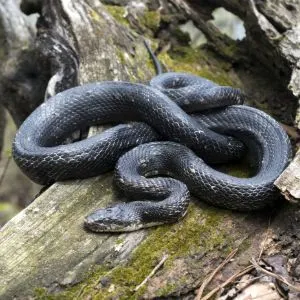
- Experience: Intermediate to expert
- Family: Colubridae
- Scientific Name: Pantherophis alleghaniensis
- Other Names: Black rat snake, pilot snake, chicken snake, yellow rat snake, Everglades rat snake
- Adult Size: 42-72 inches (106-183 centimeters)
- Lifespan: Up to 20+ years
- Average Price Range: $60
Found in the Panhandle east of the Apalachicola River and throughout the peninsula to Key Largo, eastern ratsnakes vary in coloration. In the Panhandle, this species tends to be gray with dark blotches. In the peninsula, they’re yellow, orange, tan, or gray with four dark stripes.
Eastern ratsnakes live in pinelands, hardwood hammocks, cypress strands, swamps, marshes, prairies, and fields. They subsist on small mammals, small birds, lizards, and frogs. They also are extremely good climbers. Don’t forget to look up when herping!
16. Eastern ribbon snake
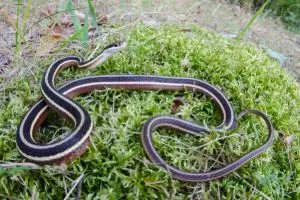
- Experience: Beginner
- Family: Colubridae
- Scientific Name: Thamnophis saurita sauritus
- Other Names: Blue-striped ribbonsnake, Peninsula ribbonsnake, common ribbonsnake
- Adult Size: 18-26 inches (46-66 centimeters)
- Lifespan: 12-20 years
- Average Price Range: $40
These slender snakes generally have a dark background with three light stripes going down their body. They also have one stripe going down the middle of the back. The stripes can be blue, yellow, brown, or white.
Eastern ribbonsnakes are found everywhere in Florida except for the Middle Keys. They inhabit pinelands, hardwood hammocks, cypress strands, prairies, and around still standing water. Diet consists of frogs, salamanders, and fish.
17. Florida brown snake
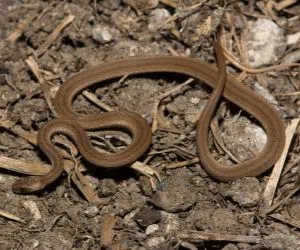
- Experience: Beginner
- Family: Colubridae
- Scientific Name: Storeria victa
- Other Names: N/A
- Adult Size: 9-13 inches (23-33 centimeters)
- Lifespan: ~7 years
- Average Price Range: $30
Florida brownsnakes reside in most wetland and terrestrial habitats throughout the peninsula as well as in the Upper Keys. These thin snakes are typically brown with a faint light dorsal stripe. Their head tends to be slightly darker than the rest of the body.
This secretive species lives underneath leaflitter, logs, and rocks. They feed on earthworms, snails, and slugs.
18. Florida kingsnake

- Experience: Intermediate
- Scientific Name: Lampropeltis floridana
- Other Names: N/A
- Adult Size: 36-48 inches (90-122 centimeters)
- Lifespan: 12-20 years
- Average Price Range: $50
Florida kingsnakes are brown to yellow in coloration with over 40 yellowish crossbands down the back. They also have a chain pattern going down the side.
South of Duval County, they live a wide variety of habitats (pinelands, hardwood hammocks, cypress strands, prairies, marshes, estuaries, and more).
Florida kingsnakes feed on small mammals, small birds, lizards, turtles, and other snakes. Interesting fact: Kingsnakes received their name due to their frequent consumption of other snakes.
19. Florida crowned snake

- Experience: N/A
- Family: Colubridae
- Scientific Name: Tantilla relicta
- Other Names: N/A
- Adult Size: 7-9 inches (18-23 centimeters)
- Lifespan: N/A
- Average Price Range: N/A
These small and thin snakes are reddish brown with a dark brown head and neck—aka the “crown.” Florida crowned snakes do not live in southern Florida or the panhandle but live everywhere in between.
Florida crowned snakes prefer sandhills, drained grassy dunes, and other dry environments. They can also be found beneath logs, rocks, and leaflitter. This species feeds only on small invertabrates and their larvae.
20. Glossy swamp snake

- Experience: N/A
- Family: Colubridae
- Scientific Name: Liodytes rigida
- Other Names: Gulf swampsnake, glossy crayfish snake
- Adult Size: 14-24 inches (36-61 centimeters)
- Lifespan: 15-30 years
- Average Price Range: N/A
This species is typically a glossy brown to olive and sometimes has a dark brown stripe going down the back. Highly aquatic creatures, glossy swampsnakes live in slow-moving bodies of water from Osceola County to the Panhandle.
They mostly feed on crayfish but will also eat fish, salamanders, and frogs.
21. Gray rat snake
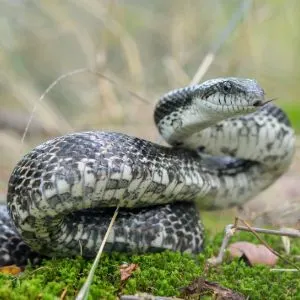
- Experience: Intermediate to Expert
- Family: Colubridae
- Scientific Name: Pantherophis spiloides
- Other Names: Oak snake, white oak snake
- Adult Size: 42-72 inches (106-183 centimeters)
- Lifespan: Up to 20 years
- Average Price Range: $80-$130
This species is light gray with darker blotches going down the back. They typically reside in the portion of the Panhandle west of the Apalachicola River, preferring pinelands, prairies, and fields. Gray ratsnakes feed mainly on rodents but also on lizards, frogs, and birds.
22. Javan file snake

- Experience: Expert
- Family: Acrochordidae
- Scientific Name: Acrochordus javanicus
- Other Names: Elephant trunk snake, wartsnake
- Adult Size: Up to 9.5 feet
- Lifespan: 12-20 years
- Average Price Range: $120
Originating in Indonesia, Javan file snakes were established in a Miami-Dade trailer park during the 1970s. This species should be attracted to slow-moving waters, however, there’s not much documentation regarding where they are in Florida.
Javan file snakes are rather big snakes with very large snouts. The average snout length for females is 53 inches (135 centimeters) and 46 inches (118 centimeters) for males. They’re typically dark with a cream-colored belly. Javan file snakes also have loose, baggy skin.
Their diet revolves around fish and amphibians.
23. Midland water snake
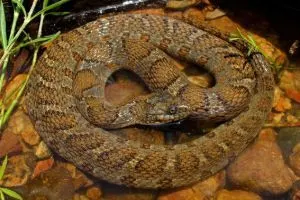
- Experience: Intermediate
- Family: Colubridae
- Scientific Name: Nerodia sipedon pleuralis
- Other Names: Common watersnake
- Adult Size: 24-30 inches (60-76 centimeters)
- Lifespan: 9-10 years
- Average Price Range: $20-$40
Midland watersnakes are light brown with darker crossbands that change into alternating blotches down the back. This species resides only in the western Panhandle and lives in streams. Their diet consists of fish and amphibians.
24. Mississippi green water snake
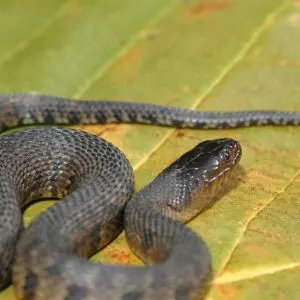
- Experience: Intermediate
- Family: Colubridae
- Scientific Name: Nerodia cyclopion
- Other Names: N/A
- Adult Size: 30-55 inches (76-140 centimeters)
- Lifespan: N/A
- Average Price Range: N/A
Only ever found in Escambia County, the Mississippi green watersnake is typically fully green with occasional markings that disappear as they age. These snakes prefer slow-moving bodies of water and eat fish and amphibians.
25. North American racer
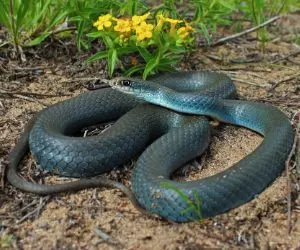
- Experience: Expert
- Family: Colubridae
- Scientific Name: Coluber constrictor
- Other Names: Runner, black racer, racer
- Adult Size: 20-56 inches (50-142 centimeters)
- Lifespan: 15-20 years
- Average Price Range: $40-$80
This speedy serpent resides throughout mainland Florida, as well as on the Florida Keys. They’re typically black or blue with white or brown markings on the chin and live in a variety of habitats (flatwoods, prairies, sandhills, and more).
The diet of a North American racer consists of small mammals, small birds, lizards, turtles, snakes, frogs, fish, small snakes, and more. They’ll pretty much eat anything. These guys can also be seen often crossing the road—fast!
26. Northern mole kingsnake

- Experience: Intermediate
- Family: Colubridae
- Scientific Name: Lampropeltis calligaster rhombomaculata
- Other Names: Mole kingsnake, brown kingsnake
- Adult Size: 30-42 inches (76-107 centimeters)
- Lifespan: N/A
- Average Price Range: $300
Northern mole kingsnakes are gray, red, or orange with 55 reddish brown blotches going down the course of the body. They reside in the Panhandle and east to Franklin and Liberty counties, living in pinelands, sandhills, prairies, and fields.
They feed on small mammals such as moles, lizards, and other snakes.
27. Pine woods litter snake
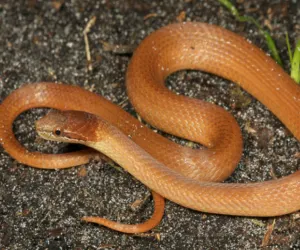
- Experience: N/A
- Family: Colubridae
- Scientific Name: Rhadinaea flavilata
- Other Names: Pine woods snake
- Adult Size: 10-13 inches (25-33 centimeters)
- Lifespan: 1-3 years
- Average Price Range: N/A
Pine woods littersnakes reside in most parts of the Florida peninsula. These snakes are fully reddish-brown and prefer areas with abundant leaflitter, hence their name.
Not much is known about pine woods littersnakes except for the fact that they’re not only fossorial but have been seen feasting on small frogs, salamanders, and lizards.
28. Plain-bellied watersnake
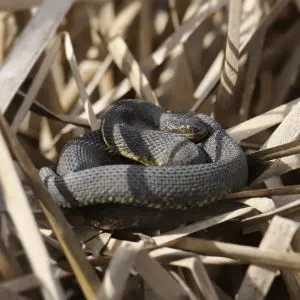
- Experience: Intermediate
- Family: Colubridae
- Scientific Name: Nerodia erythrogaster
- Other Names: Yellow-bellied watersnake, red-bellied watersnake
- Adult Size: 30-48 inches (76-122 centimeters)
- Lifespan: 8-15 years
- Average Price Range: $40
Plain-bellied watersnakes are thick-bodied snakes that are gray or brown on the top and yellow or reddish orange on their belly, neck, and lips. Found primarily in the Panhandle, this species of watersnake lives in rivers, lakes, ponds, and swamps.
Their diet consists of amphibians and freshwater fish.
29. Rainbow snake
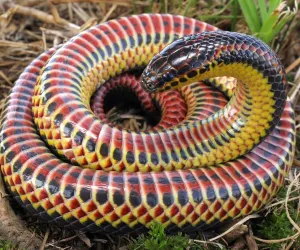
- Experience: Expert
- Family: Colubridae
- Scientific Name: Farancia erytrogramma
- Other Names: Eel moccasin
- Adult Size: 27-48 inches (69-122 centimeters)
- Lifespan: 12-19 years
- Average Price Range: N/A
A gorgeous snake, rainbow snakes are found in both the panhandle and in the northern peninsula. This species is a glossy black on the top and red on the bottom. The three red stripes that run down the body, along with the yellow and pink fading into the belly, give off the rainbow feel.
They eat eels, fish, salamanders, frogs, and earthworms.
30. Red-bellied mudsnake
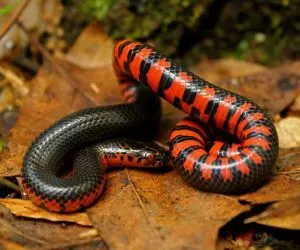
- Experience: Intermediate to expert
- Family: Colubridae
- Scientific Name: Farancia abacura
- Other Names: Eastern mudsnake
- Adult Size: 40-54 inches (102-137 centimeters)
- Lifespan: N/A
- Average Price Range: $90
Found everywhere in Florida except for the Keys, red-bellied mudsnakes are black with over 50 pinkish red bars that extend side-to-side. Their belly reflects the color of the bars. These semiaquatic snakes prefer slow-moving freshwater habitats.
Their diet revolves around aquatic salamanders. One fun fact about these guys is rather than attacking when threatened, they typically try to escape.
31. Red-bellied snake
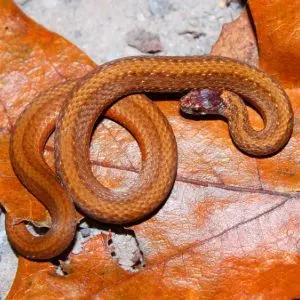
- Experience: Intermediate
- Family: Colubridae
- Scientific Name: Storeria occipitomaculata
- Other Names: Fire snake
- Adult Size: 8-10 inches (20-26 centimeters)
- Lifespan: 4 years
- Average Price Range: $60
The red-bellied snake is most commonly found in terrestrial and wetland habitats throughout the northern peninsula and the panhandle. This species is gray to reddish brown with 1-5 stripes and an unmarked red or orange underside, which makes them easily identifiable.
If it’s not a slug, they probably won’t eat it.
32. Red corn snake
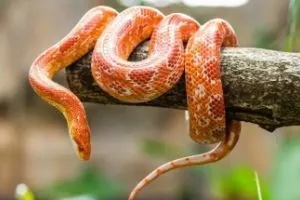
- Experience: Beginner
- Family: Colubridae
- Scientific Name: Pantherophis guttatus
- Other Names: Cornsnake, chicken snake, red ratsnake, eastern cornsnake
- Adult Size: 30-48 inches (76-122 centimeters)
- Lifespan: 6-8 years
- Average Price Range: $120
Red cornsnakes are prominent throughout Florida as they live in every county, as well as the Florida Keys. Preferred habitats include pinelands, hardwood hammocks, swamps, and agricultural fields.
They have an orangish-brown coloration with black bordered reddish-brown blotches going down the length of the body. They feed on small mammals, small birds, frogs, and lizards. Farmers tend to like having cornsnakes around as they eat the mice that try to eat their corn.
33. Rim rock crowned snake

- Experience: N/A
- Family: Colubridae
- Scientific Name: Tantilla oolitica
- Other Names: Miami black-headed snake
- Adult Size: 7-9 inches (18-23 centimeters)
- Lifespan: N/A
- Average Price Range: N/A
The second of three crowned snakes in the state of Florida, the rim rock crowned snake is a brown snake, whether it be light or dark, with a black head and neck. They can be found in pinewoods and tropical hardwood hammocks throughout Miami-Dade and Monroe Counties.
34. Ring-necked snake
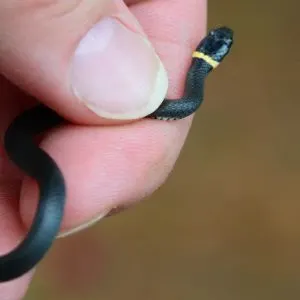
- Experience: Intermediate to expert
- Family: Colubridae
- Scientific Name: Diadophis punctatus
- Other Names: Corkscrew snake, thimble snake
- Adult Size: 8-14 inches (21-36 centimeters)
- Lifespan: 10-20 years
- Average Price Range: $30
Ring-necked snakes are typically bluish black or brownish gray with a bright orange or yellow ring around the neck. Their belly color matches the color of the ring.
These snakes can be found in every county of mainland Florida, as well as on the Florida Keys. Some ring-necked snakes in the Lower Florida Keys actually don’t have a ring. This species prefers meadows, prairies, pinelands, and both hardwood and tropical hammocks.
They feed on lizards, salamanders, frogs, toads, earthworms, and slugs. These guys also get stuck in swimming pools quite a bit.
35. Rough earthsnake
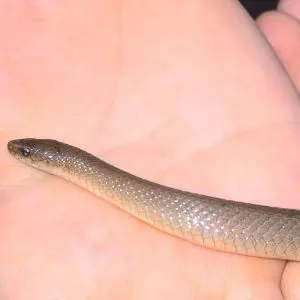
- Experience: Expert
- Family: Colubridae
- Scientific Name: Haldea striatula
- Other Names: N/A
- Adult Size: 7-10 inches (18-26 centimeters)
- Lifespan: 7 years
- Average Price Range: N/A
The rough earthsnake is small and brown in color, inhabiting the western portion of the Panhandle and the northern part of the Peninsula. They live in forested areas and are often found beneath leaflitter, rocks, and logs.
These secretive snakes also have keeled scales. They feed primarily on earthworms.
36. Rough greensnake
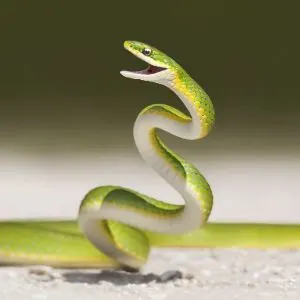
- Experience: Beginner
- Family: Colubridae
- Scientific Name: Opheodrys aestivus
- Other Names: Grass snake, green grass snake
- Adult Size: 14-33 inches (35-82 centimeters)
- Lifespan: Up to 15+ years
- Average Price Range: $30
Rough greensnakes can be found in both hardwood and bottomland forests all across the state. This species is the only bright green snake in Florida which makes it easily identifiable. Rough greensnakes are slender with yellow bellies.
They also rely heavily on vegetation to camouflage in. Rough greensnakes primarily feed on crickets, caterpillars, and grasshoppers.
37. Saltmarsh snake

- Experience: Intermediate
- Family: Colubridae
- Scientific Name: Nerodia clarkii
- Other Names: N/A
- Adult Size: 15-30 inches (38-76 centimeters)
- Lifespan: Up to 20 years
- Average Price Range: $130
A saltwater-oriented snake, the saltmarsh snake lives along the state’s coastal perimeter. They are also found on the Florida Keys and on the barrier islands. The only member of the Nerodia genera that is striped, the saltmarsh snake has two dark stripes and two lighter stripes.
They prey on fish, frogs, shrimp, and crabs.
38. Scarlet kingsnake
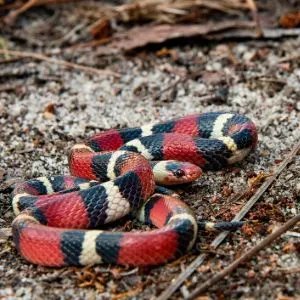
- Experience: Beginner to intermediate
- Family: Colubridae
- Scientific Name: Lampropeltis elapsoides
- Other Names: Milksnake
- Adult Size: 14-20 inches (36-51 centimeters)
- Lifespan: 20-30 years
- Average Price Range: $60-$120
Found everywhere in mainland Florida, the scarlet kingsnake has red, black, and yellowish cream bands. These guys make for a great pet, but do not mistake them for the highly venomous coral snake.
Here’s an easy trick worth remembering: “Red and black friend of Jack.” If the red and black touch, it’s a nonvenomous snake. Vice versa, if the red and black don’t touch, it’s venomous.
Scarlet kingsnakes live in wet pinelands and typically feed on lizards and small snakes.
39. Scarlet snake

- Experience: Intermediate to Expert
- Family: Colubridae
- Scientific Name: Cemophora coccinea
- Other Names: Florida scarletsnake, northern scarletsnake
- Adult Size: 14-20 inches (36-51 centimeters)
- Lifespan: 10-15 years
- Average Price Range: $50
The scarletsnake looks similar to both the scarlet kingsnake as well as the coral snake, sharing the red, black, and yellowish cream color scheme. However, scarletsnakes are blotchier.
The same goes for this species as does for the scarlet kingsnake when it comes to telling them apart from a coral snake (Remember: yellow and red bands separated by black = nonvenomous).
They’re found everywhere in Florida, exempting the Keys. This secretive snake lives in flatwoods, prairies, hardwood hammocks, and sandhills but typically stays burrowed. A scarletsnake’s diet consists primarily on reptile eggs.
40. Short-tailed kingsnake

- Experience: N/A
- Family: Colubridae
- Scientific Name: Lampropeltis extenuata
- Other Names: N/A
- Adult Size: 14-20 inches (36-51 centimeters)
- Lifespan: N/A
- Average Price Range: N/A
The sixth of Florida’s seven kingsnakes, the short-tailed kingsnake does, in fact, have a short tail, making up for just 10% or less of the snake’s total length. This snake is usually gray with 50-80 dark blotches. The easiest way to distinguish it from other kingsnake species is its small size.
Only found in the upland parts of Florida, this fossorial snake feeds exlusively on small snakes with the Florida crowned snake being one of its favorite snacks.
41. Smooth earth snake
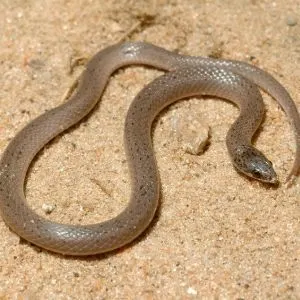
- Experience: Intermediate
- Family: Colubridae
- Scientific Name: Virginia valeriae
- Other Names: N/A
- Adult Size: 7-10 inches (18-26 centimeters)
- Lifespan: 9-10 years
- Average Price Range: N/A
Smooth earthsnakes live throughout the panhandle and a tad east. Most individuals are brown to gray and somewhat shiny, giving off the smooth-looking appearance. They also have tiny dark flecks.
They can be found in a variety of forested and edge habitats. These fossorial snakes primarily feed on slugs, snails, and earthworms.
42. South Florida mole kingsnake

- Experience: Intermediate
- Family: Colubridae
- Scientific Name: Lampropeltis occipito lineata
- Other Names: N/A
- Adult Size: 30-42 inches (76-107 centimeters)
- Lifespan: 10-15 years
- Average Price Range: N/A
Adult south Florida mole kingsnakes are usually gray or brown with 75 or more black-bordered red blotches going down the body. Found only in Florida, this species inhabits the pinelands, prairies, and fields of the peninsula.
South Florida mole kingsnakes eat lizards, small mammals, and other snakes.
43. Southeastern crowned snake
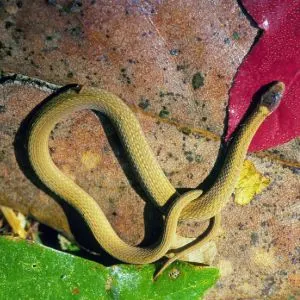
- Experience: N/A
- Family: Colubridae
- Scientific Name: Tantilla coronata
- Other Names: Southeastern black-headed snake
- Adult Size: 8-10 inches (20-26 centimeters)
- Lifespan: N/A
- Average Price Range: N/A
Living in the Panhandle and east to Leon County, the southeastern crowned is a very tiny snake that’s normally brown with a black head, representing the “crown.” This species feeds only on insects, insect larvae, snails, spiders, and centipedes.
44. Southern hog-nosed snake
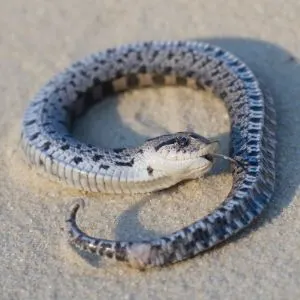
- Experience: Beginner to intermediate
- Family: Colubridae
- Scientific Name: Heterodon simus
- Other Names: Hissing adder, blow viper, cobra
- Adult Size: 18-22 inches (45-55 centimeters)
- Lifespan: 5 years
- Average Price Range: $200
This mighty cute snake resides in sandy areas throughout the Panhandle, as well as the northern and central peninsula. With its pig-like nose and small body, it’s natural to want one of these guys as a pet.
Like their cousins in the eastern hognose, southern hognoses are usually gray or tan with darker blotches. They usually eat frogs, toads, and small lizards.
45. Southern watersnake

- Experience: Intermediate
- Family: Colubridae
- Scientific Name: Nerodia fasciata
- Other Names: Banded watersnake, Florida watersnake
- Adult Size: 22-42 inches (56-107 centimeters)
- Lifespan: N/A
- Average Price Range: $50
Southern watersnakes can be found in shallow bodies of freshwater all across mainland Florida. These stout snakes have black, brown, or red crossbands that mesh with lighter narrower bands. Southern watersnakes mainly feed on frogs and fish.
46. Striped swamp snake

- Experience: N/A
- Family: Colubridae
- Scientific Name: Liodytes alleni
- Other Names: Striped crayfish snake
- Adult Size: 13-20 inches (33-51 centimeters)
- Lifespan: ~7 years
- Average Price Range: N/A
Striped swampsnakes are brownish yellow with three darker stripes. Their head seems small, in comparison to the rest of the body. These snakes live in swampy areas throughout the Florida peninsula and into the eastern Panhandle.
As their nickname suggests, striped swampsnakes feed primarily on crayfish but will also eat salamanders, frogs, and shrimp.
47. Queensnake
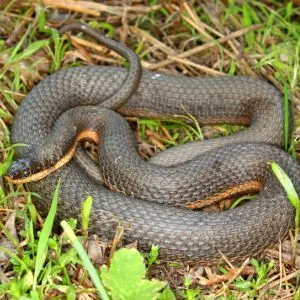
- Experience: Beginner to intermediate
- Family: Colubridae
- Scientific Name: Regina septemvittata
- Other Names: N/A
- Adult Size: 15-24 inches (38-61 centimeters)
- Lifespan: 12-19 years
- Average Price Range: $35
With six kingsnakes in Florida, you’ve got have at least one queensnake, right? The state’s queensnake resides in the Panhandle, typically hanging around rivers, streams, creeks, and marshes.
The queen snake is olive, gray, or brown and has two yellow stripes that run down its length at the first scale. These snakes also have four brown ventral stripes, which is key to identifying them. Queen snakes subsist on molted crayfish and sometimes small fish.
Venomous Snakes in Florida
48. Dusky pygmy rattlesnake

- Experience: Expert
- Family: Viperidae
- Scientific Name: Sistrurus miliarius barbouri
- Other Names: Buzzworm
- Adult Size: 12-24 inches (30-61 centimeters)
- Lifespan: Up to 20+ years
- Average Price Range: N/A
A small but thick snake, the dusky pygmy rattlesnake still very venomous. Their body color is gray with a row of charcoal blotches intersected by a red dorsal stripe that leads into the rattle. Dusky pygmy rattlesnakes can be found in every county in Florida and even on some barrier islands.
They typically reside in lowland habitats and around still standing water. Diet includes small mammals, centipedes, frogs, snakes, and lizards.
49. Eastern copperhead
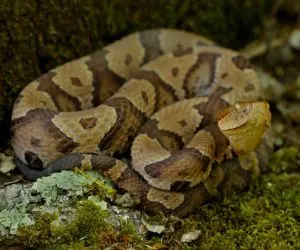
- Experience: Expert
- Family: Viperidae
- Scientific Name: Agkistrodon contortrix
- Other Names: Highland moccasin, chunk head, rattlesnake pilot
- Adult Size: 22-36 inches (56-91 centimeters)
- Lifespan: ~18 years
- Average Price Range: $100
This stout-bodied snake lives only in the Panhandle. It typically has a distinctive hourglass pattern of light and dark brown. They prefer upland pine and hardwood forests with a lot of leaflitter. An eastern copperhead’s diet consists of vertebrate prey.
50. Eastern diamond-backed rattlesnake
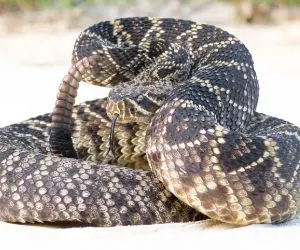
- Experience: Expert
- Family: Viperidae
- Scientific Name: Crotalus adamanteus
- Other Names: Diamondback, rattler
- Adult Size: 33-72 inches (84-183 centimeters)
- Lifespan: 15-20 years
- Average Price Range: N/A
Hence the name, these heavy-bodied snakes have large diamonds going down the course of the body. They also tend to hold their rattle above the ground.
Found in every county along with the Florida Keys and several islands in the Gulf of Mexico, diamondbacks are big fans of pine flatwoods and sand pine scrub areas. They feed on mammals and birds.
51. Florida cottonmouth

- Experience: Expert
- Family: Viperidae
- Scientific Name: Agkistrodon piscivorus conanti
- Other Names: Cottonmouth moccasin, water moccasin
- Adult Size: 30-48 inches (76-122 centimeters)
- Lifespan: less than 10 years
- Average Price Range: $200
The Florida cottonmouth’s body is made up of light brown and dark brown crossbands. It also often has spots and speckles. This venomous snake can be found inhabiting wetlands throughout every county of Florida, as well as the Keys and several barrier islands.
Florida cottonmouths feed on insects, fish, frogs, salamanders, turtles, and other snakes.
52. Harlequin coral snake
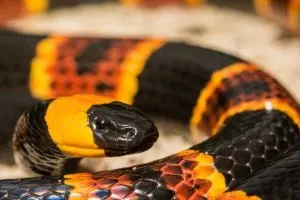
- Experience: Expert
- Family: Elapidae
- Scientific Name: Micrurus fulvius fulvius
- Other Names: Eastern Coral Snake
- Adult Size: 20-30 inches (51-76 centimeters)
- Lifespan: 6-7 years
- Average Price Range: N/A
Quite similar in looks to the scarlet kingsnake and the scarlet snake, the harlequin coralsnake is extremely venomous. Another big difference between it and the other two aforementioned species is that it’s mostly aquatic.
They live in every county, as well as Key Largo and the northern Florida Keys. Never forget that the yellow and red bands of a coralsnake touch, while the yellow and red bands of scarletsnakes and kingsnakes will always be separated by black.
Coral snakes feed exclusively on lizards and other small snakes.
53. Timber rattlesnake
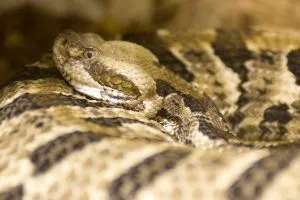
- Experience: Expert
- Family: Viperidae
- Scientific Name: Crotalus horridus
- Other Names: Canebrake, canebrake rattlesnake, timber rattler, velvet-tailed rattler
- Adult Size: 36-60 inches (76-152 centimeters)
- Lifespan: 10-20 years
- Average Price Range: $150
Florida’s timber rattlesnakes are limited, only living in 12 counties in the northern portion of the state. Their ground color is typically gray to tan with a pinkish wash and wavy black bands that cross the body.
Other features include a red line that runs down their spine and, of course, the rattle. The timber rattlesnake’s diet consists of small rodents such as mice, rats, and squirrels.
Frequently Asked Questions
Can you own a snake in Florida?
In the state of Florida, it is legal to own a pet snake. However, Florida officials have recently looked into banning the ownership of pythons. If you want to own a venomous snake in the state of Florida, you have to have a permit, 1000+ hours of experience with venomous reptiles, and two letters of reference.
What venomous snakes live in Florida?
Florida is home to six venomous snakes: dusky pygmy rattlesnake, eastern copperhead, eastern diamond-backed rattlesnake, Florida cottonmouth, harlequin coralsnake, and timber rattlesnake.
Are there snakes on Florida beaches?
Snakes will rarely, if ever, go on the popularized beaches of Florida. Of course, some snakes live in sandhills, dunes, and are found on the coastal habitats of barrier islands. But overall, the short answer is no, snakes do not go on the beach in Florida.
What snakes are common in Florida?
According to Critter Control of Orlando, the five most common snakes in Florida are the following: (1) southern watersnake, (2) eastern pinesnake, (3) North American racer, (4) eastern ratsnake, and (5) common garter snake. View their full list here.
Do snakes come out at night in Florida?
Yes, a large number of Florida’s snakes are nocturnal. For us, the best time to spot a snake is early in the morning—unless you’re a serious night owl.
Are there any cobras in Florida?
No, there are no cobras in Florida outside of captivity. The closest relative to cobras in Florida is the coralsnake.
Where are the most snakes in Florida?
If you’re scared of snakes, you’ll like this next sentence. Snakes are rarely abundant in one specific place in the state of Florida. Rather, the 53 species are spread out across the state.
Are there any anacondas in Florida?
In recent years, there has been a few sightings of anacondas in the Florida Everglades, but those snakes are not native to Florida. What probably happened was that they either escaped or were released from captivity. Will they live, reproduce, and form a 54th or maybe even a 55th species? We shall see.
What is the most dangerous snake in Florida?
No, the most dangerous snake in Florida is not the African rock python, the boa constrictor, or the Burmese python—all of which can reach 16 feet or longer. The most dangerous snake in the state of Florida is the eastern diamond-backed rattlesnake as the species kills the most people nationwide each year.
Conclusion
If you haven’t garnered this notion yet, Florida has A LOT of snakes. We hope you learned a good bit about the 53 species that reside in the Sunshine State, and hopefully, this guide will help you out next time you’re exploring the assorted geography of Florida.
Please take some time to comment in the section below and share your thoughts on Florida’s snakes with fellow snake enthusiasts. Otherwise, happy herping!
Snakes in other states
